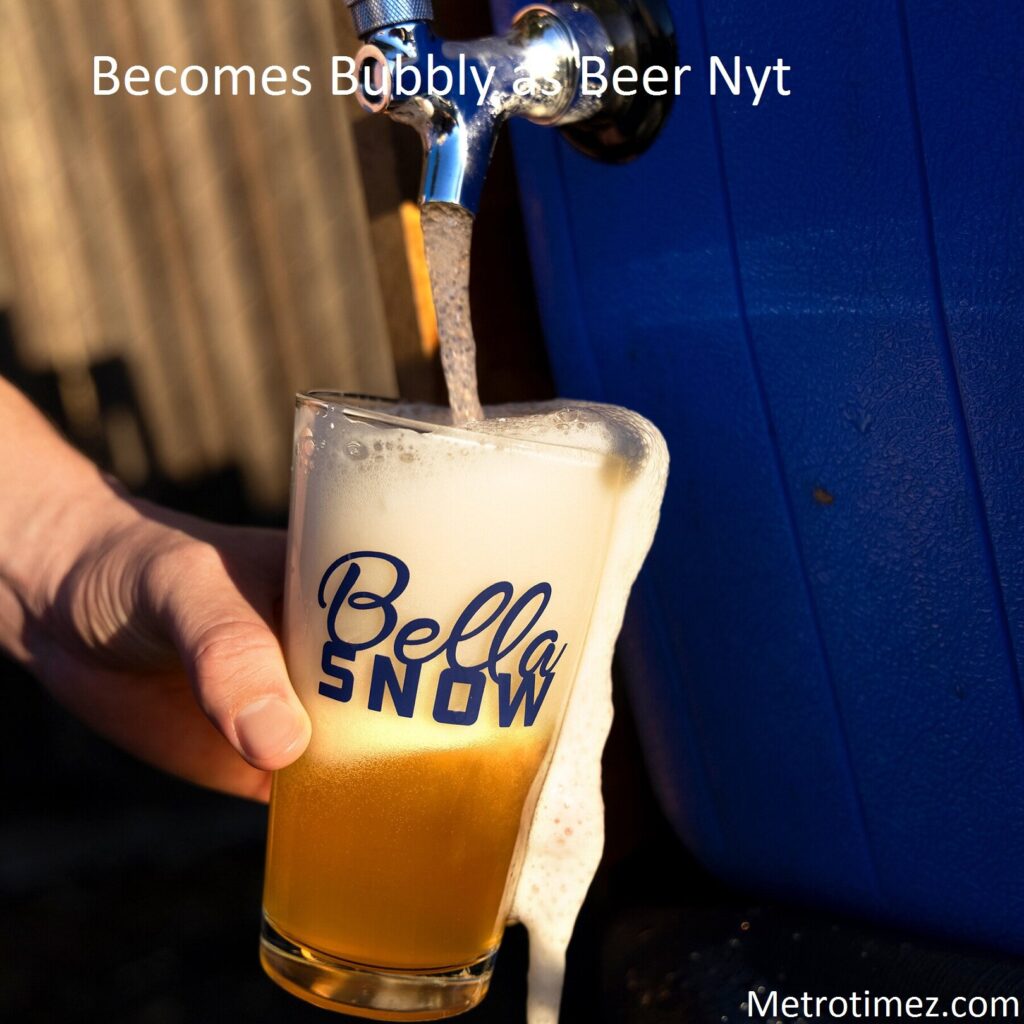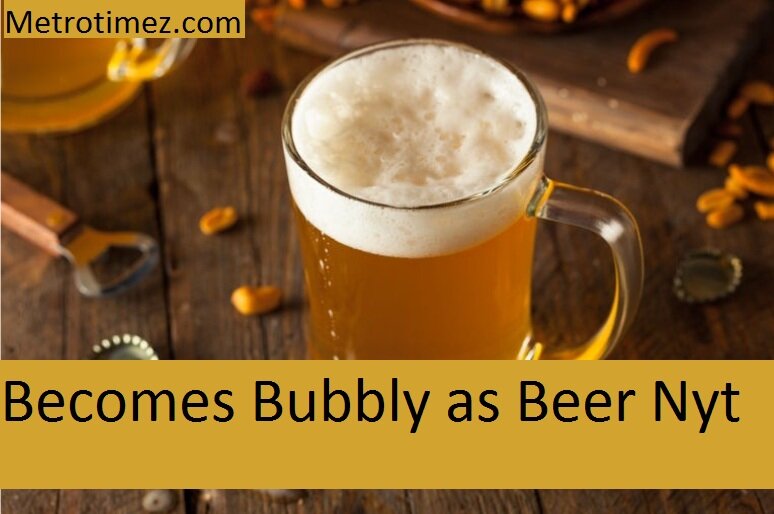
If you’ve ever enjoyed a becomes bubbly as beer nyt and savored its crisp, effervescent bubbles, you’ve likely wondered how that frothy magic comes to be. Beer’s bubbles are more than just a delightful feature; they’re a crucial part of the beer-drinking experience, affecting both flavor and aroma. So, how does beer become bubbly? Let’s dive into the science and artistry behind those sparkling bubbles.
Understanding Beer’s Carbonation in becomes bubbly as beer nyt
What Is Carbonation?
Carbonation is the presence of dissolved carbon dioxide (CO₂) in a liquid, which creates bubbles when the pressure is released. In becomes bubbly as beer nyt, carbonation is responsible for the fizz and effervescence that many beer drinkers love. This process involves both natural and artificial methods to achieve the desired level of fizziness.
Natural Carbonation
Natural carbonation occurs during the fermentation process. Yeast consumes sugars and produces alcohol and CO₂ as byproducts. This CO₂ gets trapped in the beer, creating carbonation. The level of carbonation can vary depending on the type of yeast used and the fermentation conditions.
Artificial Carbonation
Artificial carbonation involves adding CO₂ directly to the beer before it is packaged. This method allows brewers to control the carbonation levels precisely. It’s commonly used in commercial breweries to ensure consistency across batches.
The Role of Yeast in Carbonation
Fermentation and CO₂ Production
Yeast plays a crucial role in creating carbonation during fermentation. As yeast ferments the sugars in the wort (the unfermented beer), it produces alcohol and CO₂. The CO₂ dissolves in the beer, creating natural carbonation. The amount of CO₂ produced can be influenced by factors such as the type of yeast, the temperature, and the fermentation time.
Types of Yeast Used in Beer
Different types of yeast produce varying levels of CO₂ and can affect the beer’s carbonation. For example, ale yeasts typically produce a higher level of carbonation compared to lager yeasts. Understanding the type of yeast used can provide insights into the beer’s effervescence.
How Carbonation Affects Becomes Bubbly as Beer Nyt

Impact on Flavor
Carbonation enhances the beer’s flavor profile by helping to release aromatic compounds. The bubbles carry these compounds to your nose, intensifying the beer’s aroma. Additionally, carbonation can affect the perception of the beer’s sweetness and bitterness.
Texture and Mouthfeel
The level of carbonation also influences the beer’s texture and mouthfeel. Higher carbonation can create a more lively and refreshing sensation, while lower carbonation may result in a smoother, more subdued experience. This is particularly noticeable in different styles of beer, such as lagers versus stouts.
Beer Styles and Their Carbonation Levels
Lagers
Lagers are known for their clean, crisp taste and are typically highly carbonated. The carbonation enhances the beer’s refreshing quality and helps to highlight its subtle flavors.
Ales
Ales can have a wide range of carbonation levels depending on the style. For instance, pale ales may have moderate carbonation, while Belgian ales can be quite bubbly. Each style has its own carbonation profile that complements its flavor and aroma.
Stouts and Porters
Stouts and porters generally have lower carbonation levels compared to lighter beers. This lower level of carbonation contributes to their rich, creamy mouthfeel and allows their roasted flavors to shine through.
Achieving the Perfect Carbonation
Brewing Techniques
Brewers use various techniques to achieve the ideal carbonation level. For natural carbonation, they may adjust fermentation conditions, such as temperature and sugar content, to control the amount of CO₂ produced. For artificial carbonation, brewers add CO₂ during the packaging process, carefully measuring to ensure consistency.
Testing and Quality Control
Quality control is crucial in ensuring that the beer has the desired level of carbonation. Breweries test their beer for carbonation levels before it is packaged, making adjustments as needed to maintain quality and consistency.
The Science of Bubbles
How Bubbles Form
Bubbles form when CO₂ comes out of solution in the beer. This happens when the pressure is reduced, such as when you open a bottle or can. The bubbles rise to the surface, creating the frothy head that we associate with a well-poured beer.
The Role of Glassware
The type of glassware can affect the appearance and persistence of the bubbles. A clean, well-chilled glass will help maintain the carbonation and create a more appealing presentation. The shape of the glass can also influence how the bubbles rise and how the beer’s aroma is perceived.
Carbonation and Becomes Bubbly as Beer Nyt Preservation
How Carbonation Affects Shelf Life
Carbonation can impact the shelf life of beer. Over time, carbonation levels may decrease, leading to a flat beer. Proper storage and packaging help to preserve the carbonation and maintain the becomes bubbly as beer nyt freshness.
Best Practices for Storage
To keep your becomes bubbly as beer nyt, store it in a cool, dark place and avoid shaking or agitating it. This helps to maintain the carbonation and ensures that the beer remains enjoyable until you’re ready to drink it.
Conclusion
Becomes bubbly as beer nyt carbonation is more than just a fizzy feature; it’s a fundamental part of the beer-drinking experience. From the natural fermentation process to artificial carbonation methods, understanding how beer becomes bubbly adds a new layer of appreciation for your favorite brew. So next time you enjoy a cold beer, take a moment to savor the bubbles and the science behind them.
FAQs about Becomes Bubbly as Beer Nyt
What causes becomes bubbly as beer nyt?
Becomes bubbly as beer nyt due to the presence of dissolved CO₂, which forms bubbles when the pressure is released.
How does natural carbonation occur in becomes bubbly as beer nyt?
Natural carbonation occurs during fermentation when yeast produces CO₂ as a byproduct of consuming sugars in the wort.
What is the difference between natural and artificial carbonation?
Natural carbonation happens during fermentation, while artificial carbonation involves adding CO₂ directly to the beer before packaging.
How does carbonation affect the flavor of becomes bubbly as beer nyt?
Carbonation enhances the flavor by releasing aromatic compounds and affecting the perception of sweetness and bitterness.
Why is carbonation important for different becomes bubbly as beer nyt styles?
Different beer styles require varying levels of carbonation to complement their flavor profiles and achieve the desired mouthfeel.